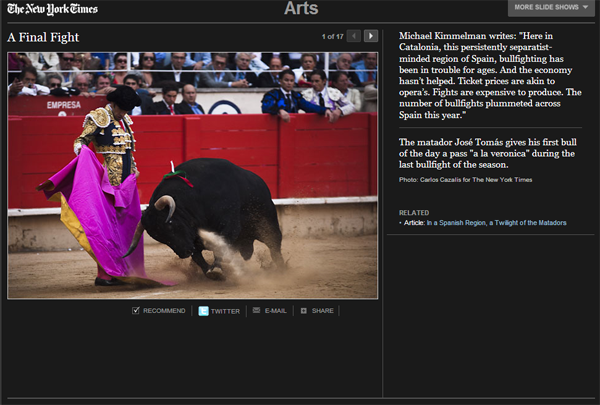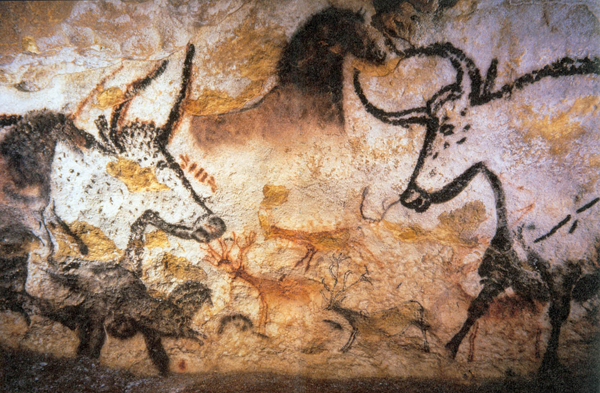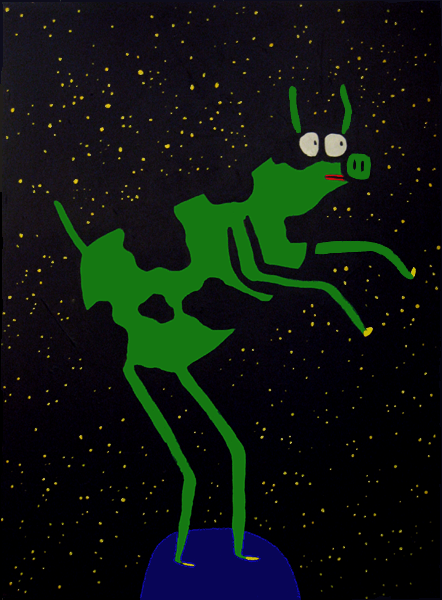Ancient Sacrifice
October 1st, 2009 by bruno boutotEnglish text follows. Puis en français. That’s the Montreal way. #
Les corridas ne sont pas un bon sujet.
Tous mes amis des bêtes vont hurler. #
Mais le premier sujet qui m’intéresse ici, c’est l’art de raconter des histoires.
Depuis des années, nytimes.com a perfectionné l’art de raconter des histoires avec quelques diapositives accompagnées de textes. C’est un art difficile et pas toujours réussi; parfois il faut se référer à l’article original ou encore les photos ne sont guères passionnantes.
Mais de temps en temps surgit une perle où un maître agence de très bonnes images et un texte bien écrit pour évoquer avec souffle, émotion et information la beauté d’un moment. #
C’est le cas ici, avec les photos de Carlos Cazalis et le texte de Michael Kimmelman. Comme c’est malheureusement l’usage, le “maître” qui a réalisé le montage reste dans l’ombre. Je recommande de prendre quelques minutes pour aller voir et lire. Il s’agit d’un événement dramatique: non seulement d’une corrida, mais sans doute la dernière en pays catalan, avec le dernier grand matador. Les arguments des opposants, qui vont probablement gagner, ne sont pas esquivés. Mais toutes les émotions historiques autour de ces instants surgissent en quelques images et quelques mots. #
Photo Carlos Cazalis Original article Michael Kimmelman
Bullfighting is not a good topic.All my PETA friends have already started howling. #
But the topic I am interested in here is the art of storytelling.
For years, nytimes.com has perfected the art of telling stories with a few slides accompanied by a few lines of text. It’s a difficult art and not always successful. Sometimes you have to go back to the original article, other times the photos are not all that special. But from time to time, there appears a jewel, where a master edits great images with a well-written text to summon the beauty of a moment with spirit, emotion and information. #
This is the case here, with photos by Carlos Cazalis and a story written by Michael Kimmelman. I recommend spending a few moments with this slideshow. Unfortunately, as is customary, the “master” editor remains in the shadows. The story is a dramatic event: not only is it a bullfight, but it is probably the last great one in Catalonia, with the last great matador. The opponents of the fights will probably win and their arguments are well-presented. But all the historical emotions surrounding such a moment are evoked by a few images and a few words. #
What moves me particularly is not the pictures of a bullfight: we can undoubtedly find thousands of others with a few clicks. These photos, however, resonate with the way Kimmelman artfully cites not only historical facts, but mythological rituals and, for me, personal experiences. #
I was born near Lascaux Caves, in the South West of France. With my parents, I had the opportunity to visit the caves several times as a kid, before they were closed to the public. Childhood memories and ancestral feelings bubble up. I still remember the cold, the dampness, and the quasi-religious reverence: like we were privileged to have a glimpse of a secret underground cathedral painted by our great-great-great-great grand-parents. #
Then, years later, I was invited by my uncle Louis-Henri and my aunt Claude to a bullfight in Toulouse. I was, at first, disgusted and skeptical, as you probably are. So I was very, very surprised when I found myself enthralled by the spectacle, chanting with the crowd, an active participant in the ceremony. I was not taking sides for the bull or for the matador. I was just drawn into something that felt like an ancient ritual of which I was a natural and devoted member. Who knows? Maybe deep in the recesses of our genes there are traces of the fear of the bulls. Maybe there are echoes of the celebrations that our tribes performed when we fought and killed one of these giants. After all, bulls, under the name of Apis, Tarvos, Bata, Tilla, Minotaur, Moloch, Agurzil and so many others, were once our gods. #
What makes a story great is how much it touches us. Thus this beautiful slideshow from nytimes.com depicting one of the last acts of this millenarian ritual makes me pay my respects to my childhood, to my ancestors, to our human history and to these former foes who have become our loyal companions and to this day give us milk, cheese and hamburgers. #
photo: Hall of the Bulls Lascaux, Wikimedia Commons Salle des taureaux
Ce ne sont pas les photos de corrida qui m’émeuvent: on peut sans doute en trouver des milliers d’autres en quelques clics. Mais ces photos résonnent ici avec l’art de Kimmelman d’évoquer non seulement des événements historiques mais aussi d’antiques rituels et, pour moi, des expériences personnelles. #Je suis né non loin des Grottes de Lascaux, dans le sud-ouest de la France. Avec mes parents, j’ai eu la chance de les visiter plusieurs fois pendant mon enfance, avant qu’elles ne soient fermées au public. De lointaines impressions remontent à la surface. Je me souviens encore du froid, de l’humidité et d’un sentiment de révérence quasi-religieuse: comme si nous avions le privilège de jeter un oeil dans une cathédrale souterraine secrète peinte par nos arrière-arrière-arrière-arrière grands parents. #
Des années plus tard j’ai été invité par mon oncle Louis-Henri et ma tante Claude à une corrida à Toulouse. J’étais de prime abord dégoûté et sceptique, comme vous l’êtes sans doute. Je fus donc très, très surpris quand je me suis retrouvé emporté par le spectacle, criant avec la foule, en train de participer activement à la cérémonie. Je n’encourageais pas le taureau ni le matador. J’étais juste aspiré dans une sorte d’ancien rituel dont j’étais tout naturellement un membre enthousiaste. Qui sait? Peut-être la peur des aurochs a-telle laissé des traces dans les confins de nos gênes? Peut-être y reste-t-il l’écho des cérémonies que célébraient nos tribus après avoir vaincu et tué l’un de ces géants? Après tout, sous les noms d’Apis, Tarvos, Bata, Tilla, Minotaur, Moloch, Agurzil et tant d’autres, les taureaux furent un jour nos dieux. #
Le propre des histoires bien racontées est qu’elles nous touchent. Ainsi, cette histoire du nytimes.com qui raconte une des dernières célébrations d’un rituel millénaire me donne l’occasion de saluer mon enfance, mes ancêtres, notre histoire humaine et ces anciens ennemis devenus nos fidèles nourricières qui nous donnent encore lait, fromages et steak-frites. #










October 3rd, 2009 at 7:41 pm
ho! la belle vache!
:-D
:-D
October 3rd, 2009 at 8:03 pm
C’est la tienne!
Elle embellit notre vie de tous les jours depuis si longtemps qu’il faut bien en faire profiter le reste de l’univers.
D’autant que, dans le contexte de l’article, elle est plus que parfaite.
Merci obom! :-)